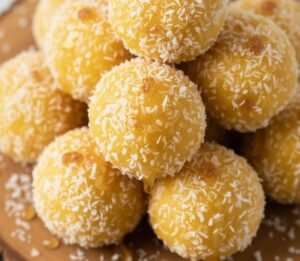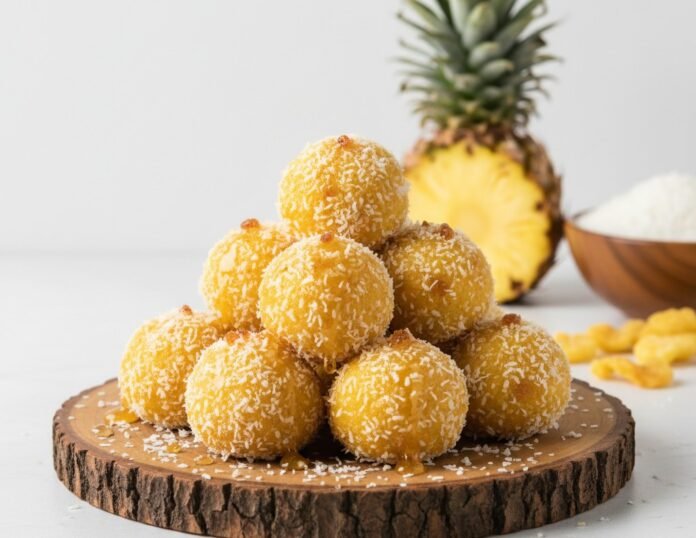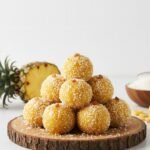Imagine the sweet, juicy tang of pineapple blended perfectly with the rich, nutty aroma of coconut — that’s what a pineapple coconut ladoo tastes like. It’s a bite-sized tropical paradise! These delightful sweets take the traditional Indian ladoo and give it a refreshing modern twist, creating something that’s both nostalgic and exciting.
What Is a Ladoo?
Ladoo (or laddu) is a popular Indian sweet, often made from flour, ghee, sugar, and various flavoring ingredients like nuts or fruits. From boondi ladoo to besan ladoo, every region in India has its own variation. The term “ladoo” itself brings memories of festivals, celebrations, and homemade treats passed down through generations.
The Fusion of Pineapple and Coconut
Now, when you add pineapple to the mix, you infuse the traditional ladoo with a tropical charm. Pineapple gives a tangy sweetness, balancing the richness of coconut beautifully. The result? A ladoo that’s vibrant in flavor, fragrant, and visually appealing — perfect for any festive table. Whether you’re making it for Diwali, Raksha Bandhan, or just to satisfy your sweet cravings, pineapple coconut ladoo is an instant hit.
The Origin and Cultural Significance of Ladoos
Ladoos are more than just sweets in Indian culture — they’re symbols of joy, blessings, and celebration. Every festival, wedding, or religious ritual feels incomplete without a plate of ladoos.
Traditional Roots in Indian Festivals
Historically, ladoos were offered as prasad (holy offering) in temples. Their round shape represents wholeness and prosperity. Ingredients varied from region to region: in South India, coconut and jaggery ladoos were popular, while in the North, gram flour and sugar dominated.
Modern Variations and Creative Twists
As culinary trends evolved, creative cooks started experimenting with fruits, chocolates, dry fruits, and even exotic flavors. Pineapple coconut ladoo is one such modern twist — merging Indian tradition with tropical flavors. It’s not just delicious but also visually stunning, making it a trending dessert for Instagram-worthy festive spreads.
Why Pineapple Coconut Ladoo Is Special
So, what makes this ladoo stand out among hundreds of other sweets? It’s the balance — between tangy and sweet, creamy and chewy, traditional and modern.
Unique Flavor Profile
Coconut adds a mild sweetness and creamy texture, while pineapple provides a refreshing zest that cuts through the richness. Together, they create a symphony of flavors that’s hard to resist. The natural aroma of these two tropical ingredients fills the kitchen as soon as you start cooking, giving off that beachy, holiday vibe.
Nutritional Benefits
Aside from the taste, this ladoo is also nutrient-rich. Pineapple is packed with vitamin C, antioxidants, and enzymes that aid digestion. Coconut provides healthy fats, fiber, and essential minerals. When you prepare it with natural sweeteners like jaggery or honey, it becomes a guilt-free indulgence — sweet enough to please your taste buds, but light enough to enjoy without worry.
Ingredients You Need for Pineapple Coconut Ladoo
Before you start cooking, let’s look at what you’ll need. The ingredient list is short and simple — that’s part of the magic of this recipe.
Fresh vs. Canned Pineapple
You can use either fresh or canned pineapple. Fresh pineapple gives a brighter flavor and natural sweetness, while canned pineapple (in its own juice, not syrup) is convenient and consistent. If you’re using fresh pineapple, make sure to peel and core it properly, then chop it into small pieces before blending it into a puree.
Choosing the Right Coconut
For the best texture, use freshly grated coconut or frozen grated coconut. Desiccated coconut also works if you roast it lightly first to bring out the aroma. The fresher your coconut, the creamier and more flavorful your ladoos will be.
Sweeteners and Flavor Enhancers
You can choose from various sweeteners depending on your preference:
-
Condensed milk: Adds richness and helps bind the mixture.
-
Sugar: Traditional and easy to control for sweetness.
-
Jaggery or honey: Perfect for a healthier version.
To enhance the flavor, add a touch of cardamom powder or a few drops of pineapple essence. Garnish with chopped nuts or dried pineapple bits for extra texture.
Step-by-Step Recipe for Pineapple Coconut Ladoo
Now comes the fun part — making these little tropical delights.
Preparation of Pineapple Puree
-
Take about 1 cup of chopped pineapple (fresh or canned).
-
Blend it into a smooth puree — you can leave it slightly chunky if you like texture.
-
Strain if it’s too watery.
Cooking the puree slightly in a pan before mixing it helps remove excess moisture and intensifies the flavor.
Roasting Coconut for Texture
Heat a non-stick pan and dry roast 2 cups of grated coconut on low flame until it turns aromatic and slightly golden. Be careful not to brown it too much, or it will lose its sweetness.
Mixing, Cooking, and Rolling Ladoos
-
In the same pan, add a teaspoon of ghee or coconut oil.
-
Pour in the pineapple puree and cook until it thickens slightly.
-
Add the roasted coconut and mix well.
-
Stir in ½ cup of condensed milk or sugar and cook until the mixture leaves the sides of the pan.
-
Let it cool for a few minutes, then roll into small balls.
-
Coat each ladoo in some dry coconut for that classic festive look.
You can refrigerate them for 15–20 minutes before serving for a firmer texture.
Tips to Perfect Pineapple Coconut Ladoo Every Time
Making ladoos might seem simple, but achieving the perfect texture and flavor takes a few tricks. Pineapple has natural juices, which can make the mixture a bit sticky, so precision and patience are key.
Balancing Sweetness and Tartness
Pineapple brings a natural tang that beautifully complements the sweetness of coconut. However, too much pineapple puree can overpower the flavor and make the mixture runny. To balance it:
-
Use ripe pineapple for natural sweetness.
-
Adjust sugar or condensed milk gradually.
-
Add a pinch of salt — yes, salt! It enhances the sweetness and deepens the flavors.
If your pineapple is overly sour, balance it with a few teaspoons of jaggery or honey. These natural sweeteners also add a richer taste and color to your ladoos.
Texture and Consistency Secrets
The trick to perfect ladoos lies in the consistency of the mixture. It should be soft enough to roll but firm enough to hold its shape.
-
Cook the pineapple-coconut mixture until it leaves the sides of the pan and thickens.
-
Let it cool slightly before shaping — warm mixture binds better.
-
If it’s too sticky, add a bit more roasted coconut.
-
For extra richness, mix in a tablespoon of milk powder or desiccated coconut.
The final touch? Roll them gently between your palms, coat with dry coconut, and you’ll get smooth, glossy ladoos that look as good as they taste.
Variations You Can Try
The beauty of this recipe lies in its versatility. You can tweak it based on your taste, dietary needs, or creativity.
Pineapple Coconut Ladoo with Condensed Milk
If you want a richer, creamier ladoo, condensed milk is your best friend. It simplifies the process — no need for extra sugar or ghee.
-
Roast coconut lightly.
-
Add condensed milk and pineapple puree directly to the pan.
-
Stir continuously until the mixture thickens.
This version gives your ladoos a fudge-like texture with a melt-in-your-mouth feel. You can even top them with a small piece of pineapple or a sprinkle of saffron for that extra festive touch.
Vegan and Sugar-Free Versions
For a healthier twist, go vegan! Replace ghee with coconut oil and skip condensed milk entirely. Instead, use:
-
Coconut cream for creaminess.
-
Date paste or maple syrup as natural sweeteners.
-
A few crushed cashews or almonds for a nutty crunch.
These ladoos are dairy-free, refined-sugar-free, and still taste divine. Perfect for anyone following a plant-based lifestyle or looking for a guilt-free treat.
Storing and Shelf Life
After putting your heart into making these delightful sweets, you’ll want to keep them fresh and flavorful for as long as possible. Luckily, pineapple coconut ladoos have a decent shelf life if stored properly.
Refrigerator vs. Room Temperature Storage
If you’ve used condensed milk or fresh coconut, it’s best to store them in the refrigerator. They’ll stay fresh for up to 5 days in an airtight container. When serving, bring them to room temperature to soften slightly.
If your recipe is vegan or uses desiccated coconut with minimal moisture, you can keep them at room temperature for 2–3 days in a cool, dry place. Avoid humid areas, as coconut tends to absorb moisture quickly.
Tips for Long-Lasting Freshness
-
Line the container with parchment paper to prevent sticking.
-
Avoid stacking ladoos — layer them with butter paper.
-
Do not freeze; it changes the texture of coconut and makes it dry.
These small precautions ensure your ladoos taste just as heavenly even after a few days.
Serving Suggestions and Presentation Ideas
Ladoos are not just about taste; presentation matters too — especially during festivals or when gifting.
Perfect for Festive Platters
Arrange your pineapple coconut ladoos on a silver or brass platter, sprinkle some edible gold dust or desiccated coconut on top, and garnish with small pineapple wedges or mint leaves. The vibrant yellow color of the pineapple makes these ladoos stand out beautifully among other sweets.
For Diwali, place them in decorative boxes lined with tissue paper and tie a satin ribbon for an elegant finish. They make excellent homemade gifts that add a personal touch to your celebrations.
Pairing with Other Indian Desserts
These ladoos pair wonderfully with light Indian sweets such as:
-
Rasgulla or Sandesh: for a Bengali-inspired dessert spread.
-
Kesar Peda or Coconut Burfi: to complement the tropical flavors.
-
Chilled Phirni or Kheer: for a balance of warm and cool textures.
Serve them after meals or as part of a high-tea spread — they never fail to impress!

Health Benefits of Pineapple Coconut Ladoo
Who said sweets can’t be healthy? When made with natural ingredients and minimal sugar, pineapple coconut ladoo offers surprising health benefits.
Nutrient Profile of Pineapple and Coconut
-
Pineapple: Rich in vitamin C, manganese, and bromelain (an enzyme that supports digestion and reduces inflammation).
-
Coconut: Packed with dietary fiber, healthy fats (MCTs), iron, and potassium.
Together, they create a nutrient-dense sweet that supports energy levels, improves digestion, and even boosts immunity.
Why It’s a Better Choice Than Regular Mithai
Traditional Indian sweets often rely heavily on sugar and ghee, making them high in calories. Pineapple coconut ladoo, however, uses fruit-based sweetness and minimal fat. With simple substitutions like jaggery or coconut sugar, it becomes a wholesome indulgence.
It’s not just a dessert; it’s a nutritious snack disguised as a treat — perfect for kids, adults, and even fitness enthusiasts looking for a natural energy boost.
Common Mistakes to Avoid While Making Ladoos
Even experienced cooks sometimes face challenges while making ladoos. Let’s fix those before they happen!
Overcooking or Undercooking Mixture
Overcooking the pineapple mixture can lead to caramelization, altering the taste and making it too hard. Undercooking leaves it watery, making it impossible to roll. The ideal stage is when the mixture thickens and leaves the pan’s sides cleanly.
Stir constantly on low heat — patience is your best tool here!
Issues with Binding and Shape
If your ladoos aren’t holding their shape:
-
Add more roasted coconut or milk powder.
-
Refrigerate the mixture for 10 minutes before shaping.
-
Lightly grease your palms with ghee or oil before rolling.
And remember — consistency improves with practice. The more you make, the better you get!
Fun Facts About Pineapple and Coconut
Pineapple and coconut are two tropical ingredients that not only taste heavenly together but also share fascinating stories and uses across cultures.
Tropical Origins and Culinary Uses
Pineapple originated from South America, primarily from regions like Brazil and Paraguay, before spreading to the rest of the world through explorers and traders. It became a symbol of hospitality in many cultures — a pineapple at the entrance of a home was considered a welcoming gesture. Today, it’s used in everything from juices and jams to savory dishes like pineapple fried rice and pizza (yes, the famous pineapple-on-pizza debate!).
Coconut, on the other hand, is known as the “Tree of Life.” Every part of the coconut is useful — water for hydration, oil for cooking and skincare, and flesh for desserts and curries. In Indian culture, breaking a coconut before beginning something new symbolizes purity, prosperity, and divine blessing.
When these two tropical treasures unite in the form of ladoos, they bring not just flavor but a piece of history and culture in every bite.
Symbolism in Different Cultures
-
In Hindu rituals, coconuts are considered sacred and used in almost every ceremony.
-
Pineapple, in many Western cultures, stands for warmth and friendship.
-
Together, they represent celebration and abundance — exactly what a ladoo embodies in Indian tradition.
So, when you prepare pineapple coconut ladoo, you’re not just making a dessert — you’re blending centuries of cultural symbolism into a single, joyful treat.
Pineapple Coconut Ladoo for Special Occasions
This dessert isn’t just perfect for your sweet cravings; it’s also a wonderful addition to festive celebrations, gatherings, and even thoughtful gifting.
As a Gift or Prasad
Because of its appealing color, tropical aroma, and rich flavor, pineapple coconut ladoo makes a beautiful edible gift. You can pack them in colorful boxes with dry flowers or festive ribbons — they look premium and are made with love.
In religious events, they also serve beautifully as prasad (holy offering). Unlike traditional ghee-based sweets that spoil quickly, these ladoos stay fresh longer, making them ideal for temple offerings or community distributions.
For Parties and Family Gatherings
Want to impress guests at a dinner party? Serve pineapple coconut ladoos chilled, topped with a small mint leaf or edible flower. They add elegance to any dessert table. For children’s parties, roll them in colored coconut flakes or coat them lightly in chocolate — both visually fun and deliciously unique.
Their freshness and tropical vibe also make them perfect for summer celebrations or beach-themed events. Wherever they appear, they steal the spotlight effortlessly.
Conclusion
Pineapple Coconut Ladoo isn’t just another sweet — it’s a fusion of tradition and tropical flair that brings together the best of both worlds. With the vibrant tang of pineapple and the creamy sweetness of coconut, these ladoos redefine Indian mithai in a refreshing way.
They’re easy to make, visually stunning, and incredibly versatile. Whether you serve them during festivals, gift them to loved ones, or simply treat yourself, every bite carries a burst of flavor and a touch of joy.
And the best part? You can experiment endlessly — go vegan, make them healthier, or add your personal twist. So next time you crave something sweet yet different, skip the store-bought desserts and whip up a batch of pineapple coconut ladoos. Trust me, once you taste them, they’ll become a permanent part of your festive menu.
FAQs
1. Can I use canned pineapple for this recipe?
Yes, absolutely! Just make sure to use canned pineapple in juice, not syrup, to avoid excess sweetness. Drain it well before blending into a puree.
2. How long can I store pineapple coconut ladoos?
If made with fresh ingredients, they can be stored in the refrigerator for up to 5 days in an airtight container. For longer storage, use desiccated coconut and keep them cool and dry.
3. Can I make these ladoos without condensed milk?
Yes, you can replace condensed milk with jaggery syrup, coconut cream, or date paste for a dairy-free version. Adjust sweetness according to taste.
4. Why are my ladoos not binding properly?
This usually happens when the mixture is too wet. Try cooking it a bit longer to evaporate moisture or add more roasted coconut or milk powder.
Pineapple Coconut Ladoo Recipe | Easy Indian Sweet with Tropical Flavors
If you love Indian sweets and tropical flavors, Pineapple Coconut Ladoo is the perfect fusion dessert for you! These golden, bite-sized delights are soft, juicy, and bursting with the sweetness of coconut blended with the tangy freshness of pineapple.
- Prep Time: 10 minutes
- Cook Time: 20 minutes
- Total Time: 30 minutes
- Yield: 12–15 ladoos
- Category: Dessert / Sweet
- Cuisine: Indian Fusion
Ingredients
- 1 cup fresh or canned pineapple (chopped)
- 2 cups grated coconut (fresh or desiccated)
- ½ cup condensed milk or sugar
- 1 tbsp ghee or coconut oil
- ½ tsp cardamom powder
- ¼ cup dry grated coconut (for coating)
- 2–3 drops pineapple essence (optional)
Instructions
- Blend the chopped pineapple into a smooth puree.
- Cook it in a non-stick pan on medium heat for 3–4 minutes to remove excess moisture.
- In a separate pan, dry roast grated coconut on low flame until aromatic and slightly golden.
- Set aside a small portion for coating later.
- In the same pan, melt ghee or coconut oil.
- Add the pineapple puree and stir well.
- Mix in the roasted coconut and condensed milk (or sugar).
- Cook on low flame until the mixture thickens and leaves the sides of the pan.
- Add cardamom powder and pineapple essence (optional).
- Allow the mixture to cool slightly.
- Grease your palms with a little ghee and roll small portions into round ladoos.
- Roll each ladoo in dry coconut for a festive look.
- Store in an airtight container.
- Keeps well for 3–5 days in the refrigerator.
Notes
- Use ripe pineapple for natural sweetness.
- If the mixture feels sticky, add a little more coconut.
- For a vegan version, replace condensed milk with coconut cream and ghee with coconut oil.
- Add a pinch of salt to enhance the sweetness naturally.









